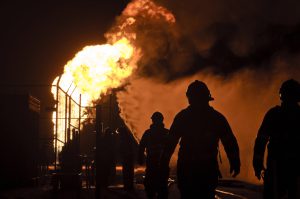The Incident
Flixborough chemical works had been managed safely for many years, with no notable accidents, until temporary repairs and modifications to maintain production were carried out after a six foot crack developed in one of the six inline reactors. A proper engineering inspection and risk assessment were not carried out, and changes in the process were not reviewed before restarting the process.
On Saturday 1st June 1974, Flixborough chemical works was virtually demolished by a release of cyclohexane to the atmosphere and consequential explosion of warlike dimensions. 28 people working on the site at the time were killed and 36 people were injured. Outside the works 53 people were injured. 1,821 houses and 167 shops and factories were damaged.
The Causes
This case revealed a serious lack of Management control, because no one thought about the impacts of restarting without finding the cause of the crack to Reactor number 5 or stripping and inspecting the other five reactors to see if any of them had similar faults. Reactor number 4 was connected to number 5 it involved a major technical problem or was more than just a routine plumbing job but a major technical problem. A suitably qualified engineer would likely have insisted that all reactors should be thoroughly inspected and the cause of the problem with reactor number 5 identified before the system was restarted. However, problems continued to develop and more leaks were found up to and including the 1st June 1974.
The court of enquiry criticised the temporary bridge pipe that was installed between two thin walled bellows pieces which failed. The wall thickness was much less than the usual corrosion allowance that most pressure vessels have. Even with a regular metal inspection programme it is unwise to employ large diameter and highly stressed thin walled bellows. This was a serious series of errors that would cause all similar chemical industries to look at the effectiveness of their own control methods.
Conclusion
With the above series of events a catastrophic disaster seemed inevitable and should have been foreseen. Large quantities of flammable gasses and vapours when mixed with air can undergo surprisingly violent and forceful explosions when unconfined.
Most installations from which an unconfined vapour cloud explosion might originate are classified as notifiable installations and would be subject to scrutiny to the HSE’s Major Hazards Risk Appraisals group, consisting of inspectors with expertise in explosives, fire and chemical hazards.
Reporting near misses and properly investigating their root causes can prevent similar, more serious incidents occurring.
Assent Risk Management’s Health & Safety Consultants can help you establish a risk management framework to provide proper governance and leadership oversight of health & safety issues within your organisation.
Contact us to find out more.


